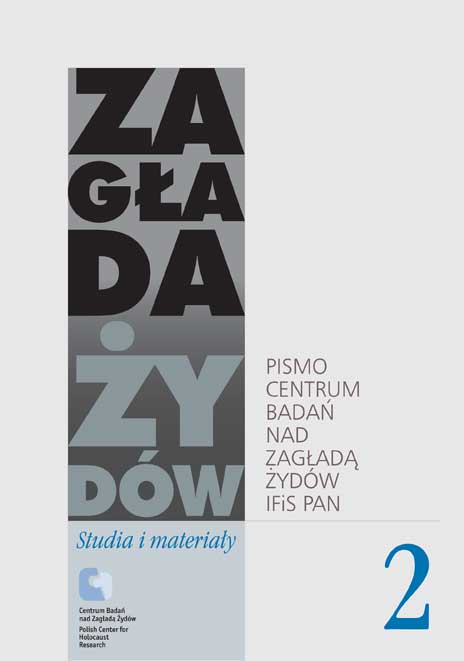Od agenta do kolaboranta? Współpraca żydowskiego publicysty Fritza Seiftera z Bielska z władzami niemieckimi w latach trzydziestych i czterdziestych
Zagłada Żydów. Studia i Materiały, Nr 2 (2006), Strony: 163-176
Data zgłoszenia: 2020-10-11Data publikacji: 2006-12-02
 https://doi.org/10.32927/ZZSiM.185
https://doi.org/10.32927/ZZSiM.185
Abstrakt
Fritz Seifter, a Jewish-German journalist and Polish citizen, collaborated with the German authorities on two occasions: first during 1933–1934 in Bielsko, where, supported by the Reich Ministry of National Education and Propaganda, he launched his newspaper Jüdische Wochenpost; second, in July 1940, when the General Governor's Department of National Education and Propaganda in Cracow appointed him editor-in-chief and managing director of Gazeta Żydowska. But in either case the circumstances and motives for collaboration differed significantly.
In the case of Jüdische Wochenpost, Seifter completed a project he had been planning to carry out since the late 1920s. His newspaper was to consolidate the bonds of German-speaking Polish Jews with Germany. The Reich Ministry of National Education and Propaganda supported the establishment of this newspaper in order to tone down the opinions of Polish Jews regarding the Nazi regime in Berlin. During 1933–1934 Seifter saw himself as an agent of the German Ministry of Propaganda.
In 1940, German occupation authorities in Krakow searched for and found Fritz Seifter, who was to be appointed editor-in-chief and managing director for the German-planned Gazeta Żydowska, completely controlled by the Germans. Its principal aims were to isolate the Jews even further from their Polish environment, herd them to work and give illusions of hope for emigration after the war.
Thus there was no continuity in Seifter's co-operation with the German authorities, and collaboration was not the case. During 1933–1934, Seifter's main reason to launch his newspaper was German nationalism, which ostensibly linked him to the Germans. In 1940, however, Fritz Seifter no longer acted of his own accord, and any illusions as to the genocidal character of the Nazi regime was out of the question: Seifter alongside the rest of Polish Jews wanted only to survive.
Słowa kluczowe
Friedrich Seifert , stosunki polsko-niemieckie , stosunki niemiecko-żydowskie , prasa codzienna , propaganda , narodowy socjalizm , okupacja , kolaboracja
Licencja
Prawa autorskie (c) 2006 Autor&"Zagłada Żydów. Studia i Materiały"

Utwór dostępny jest na licencji Creative Commons Uznanie autorstwa 4.0 Międzynarodowe.
https://creativecommons.org/licenses/by/4.0
Czasopismo publikowane jest w standardzie Diamond Open Access na licencji CC-BY-4.0 Deed - Uznanie autorstwa 4.0 Międzynarodowa - Creative Commons
Podobne artykuły
- Dariusz Libionka, Jacek Leociak, 75. rocznica akcji „Reinhardt” , Zagłada Żydów. Studia i Materiały: Nr 13 (2017)
- Jan Grabowski, Klaus-Michael Mallmann, Martin Cüppers, Półksiężyc i swastyka. III Rzesza a świat arabski , Zagłada Żydów. Studia i Materiały: Nr 5 (2009)
- Jacek Walicki, Wydział Archiwum getta łódzkiego a Archiwum Ringelbluma , Zagłada Żydów. Studia i Materiały: Nr 16 (2020)
- Dariusz Libionka, Michael Phayer, Pius XII, Holocaust and the Cold War , Zagłada Żydów. Studia i Materiały: Nr 5 (2009)
- Monika Polit, Tekst zwany 'Dziennikiem Szmula Rozensztajna' , Zagłada Żydów. Studia i Materiały: Nr 2 (2006)
- Karolina Panz, Agnieszka Wierzcholska, Wspomnienia i kamienie. Życie i śmierć polsko-żydowskiego miasta Tarnów 1918–1956 , Zagłada Żydów. Studia i Materiały: Nr 20 (2024)
- Karolina Panz, „Dlaczego oni, którzy tyle przecierpieli i przetrzymali, musieli zginąć”. Żydowskie ofiary zbrojnej przemocy na Podhalu w latach 1945–1947 , Zagłada Żydów. Studia i Materiały: Nr 11 (2015)
- Dariusz Libionka, Joshua D. Zimmerman, The Polish Underground and the Jews, 1939–1945 , Zagłada Żydów. Studia i Materiały: Nr 12 (2016)
- Krzysztof Persak, Ekshumacja, której (prawie) nie było. Prace archeologiczno-ekshumacyjne w Jedwabnem w 2001 r. i ich wyniki , Zagłada Żydów. Studia i Materiały: Nr 14 (2018)
- Dariusz Libionka, David Silberklang, Gates of Tears: The Holocaust in the Lublin District , Zagłada Żydów. Studia i Materiały: Nr 11 (2015)
<< < 1 2 3 4 5 6 7 8 9 10 11 12 13 14 15 16 17 18 19 20 21 22 23 24 25 26 27 28 29 30 31 32 > >>
Możesz również Rozpocznij zaawansowane wyszukiwanie podobieństw dla tego artykułu.
 English
English
 Język Polski
Język Polski




